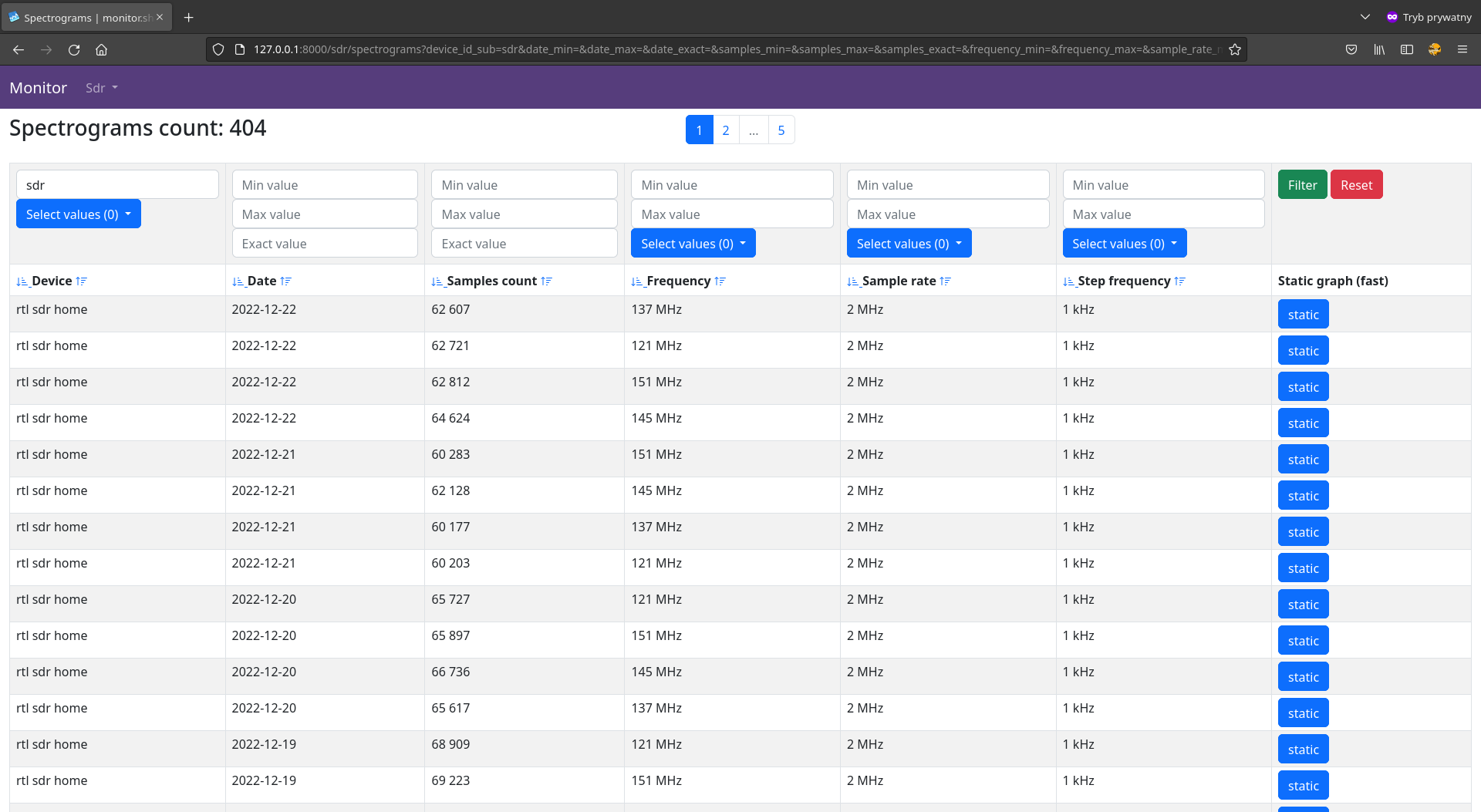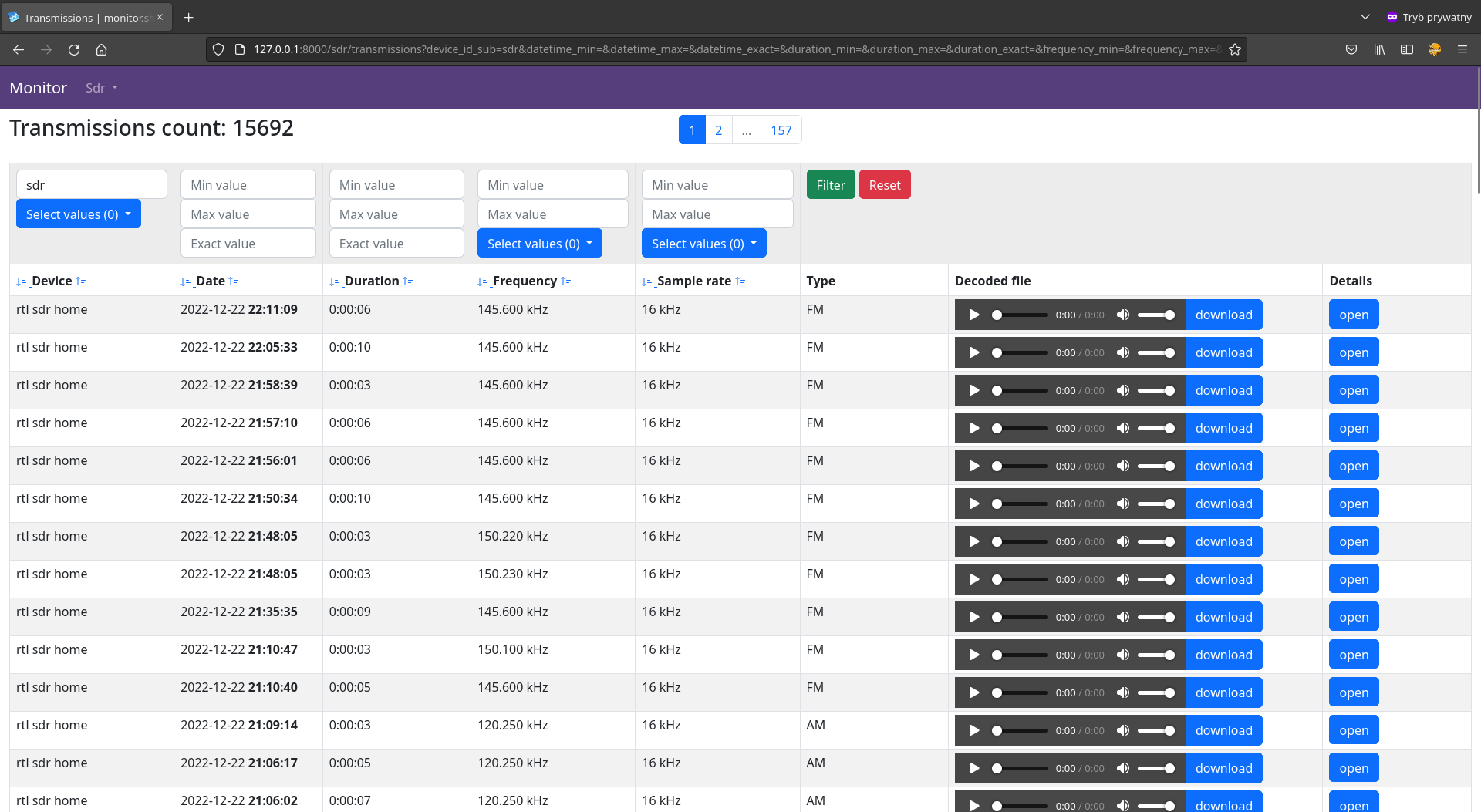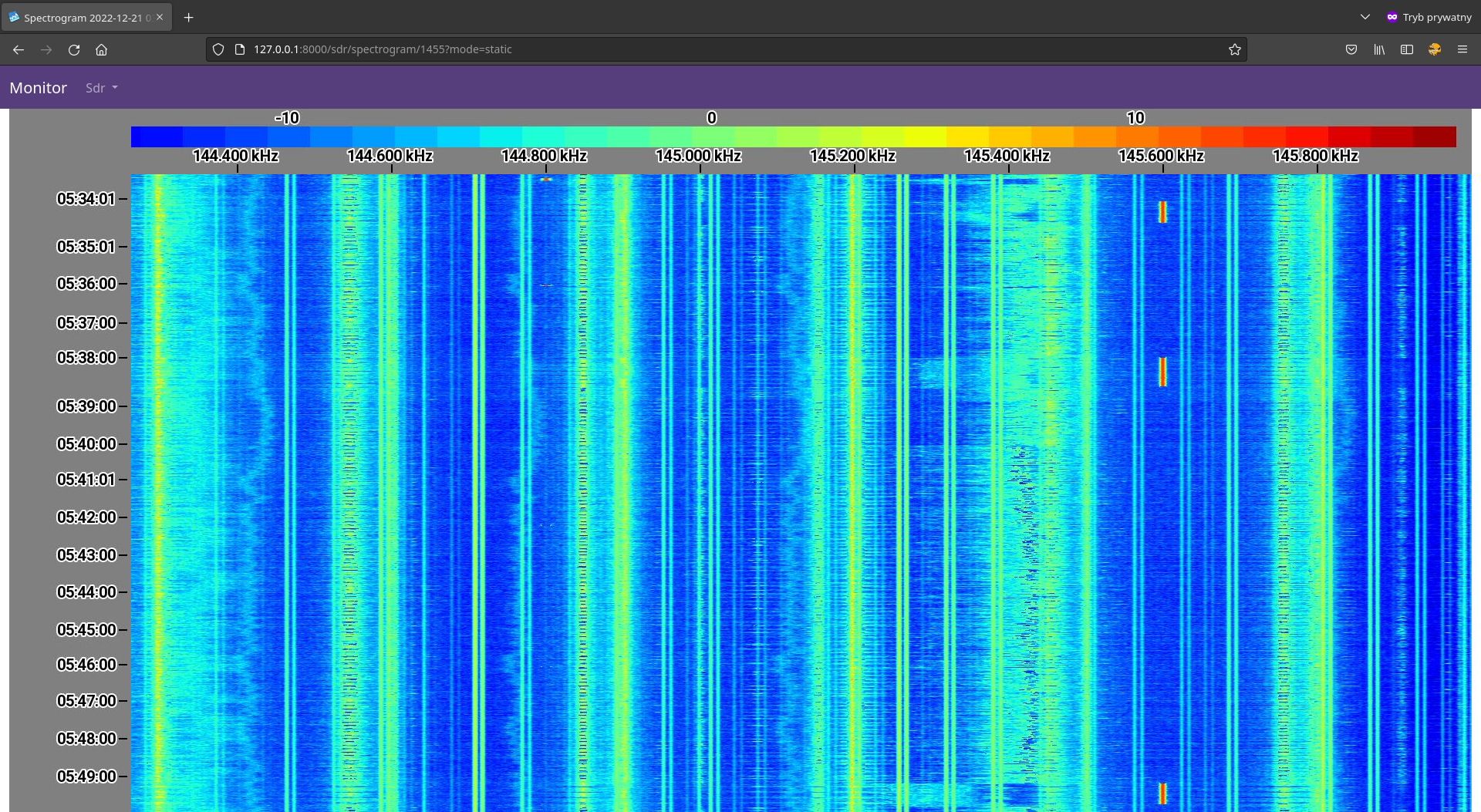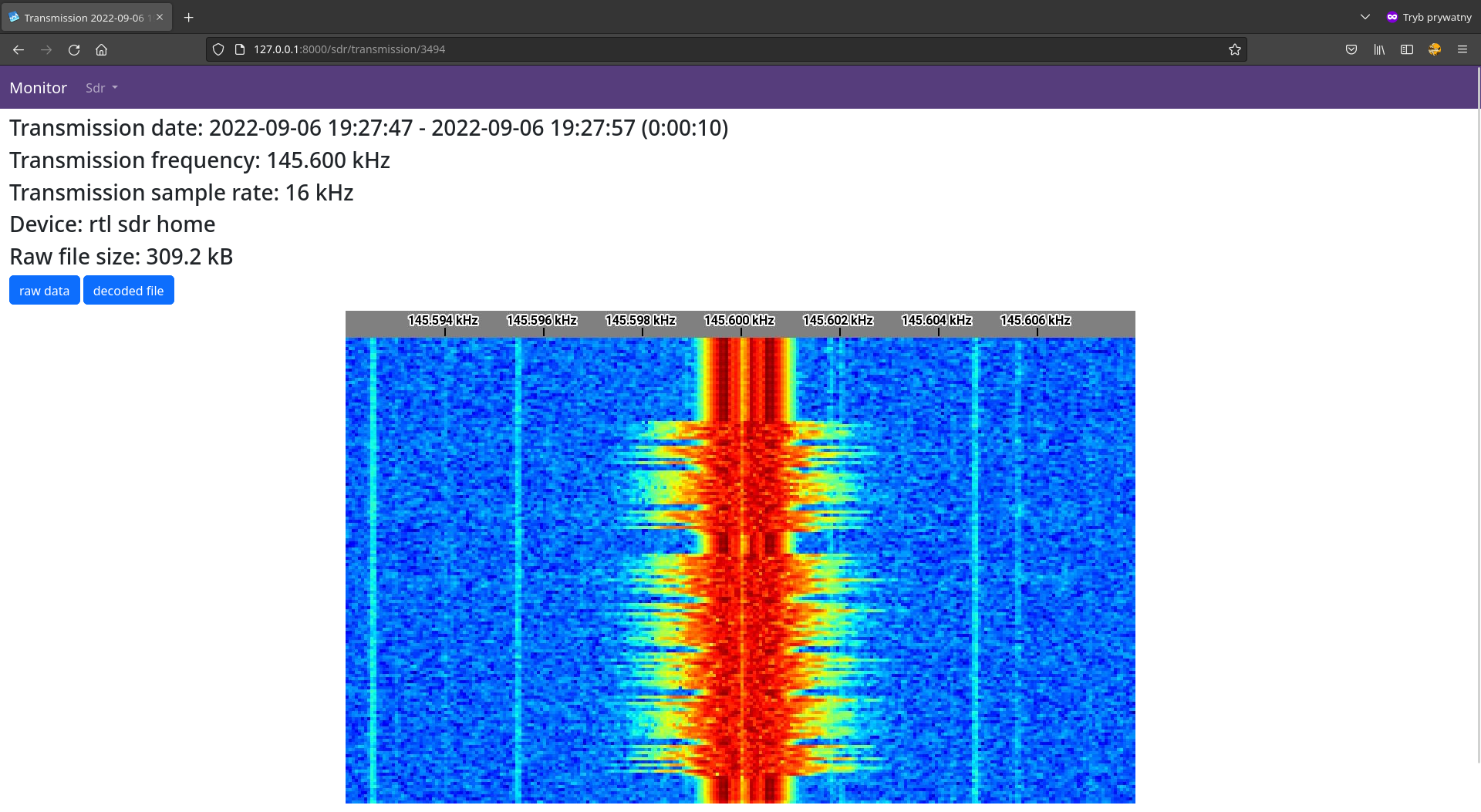This project contains sdr scanner written in c++ to scan and record multiple interesting frequencies bandwidth in the same time (eg. 108 MHz, 144 MHz, 440 Mhz, etc). This is possible by switching quickly between frequencies bandwidth.
Sdr scanner also allows you to record multiple transmissions simultaneously (if they are transmitted on the same band). For example, if one transmission is on 145.200 MHz and the other is on 145.600 MHz, the scanner will record and save both!
It also provides easy but very powerful web panel to explore recordings and spectrograms.
rtl-sdrHackRF
| Spectrogram | Transmission |
|---|---|
 |
 |
 |
 |
If you do not have docker installed, follow the instructions available at https://docs.docker.com/desktop/ to install docker and docker compose.
Download sample configuration and docker file, then run it. Customize config.json to your needs.
mkdir -p sdr
cd sdr
wget https://github.com/shajen/rtl-sdr-scanner-cpp/raw/master/config.json
wget https://github.com/shajen/rtl-sdr-scanner-cpp/raw/master/docker-compose.yml
docker compose up
Wait a moment to collect data and open panel.
To update docker images to latest version type:
docker compose pull
Open http://localhost:8000/sdr/spectrograms/ and wait for data to collect.
Admin panel available at http://127.0.0.1:8000/admin/. Username: admin, password: password.
All of the following examples should be used in the config.json file.
To scan single frequency range:
{
"scanner_frequencies_ranges": [
{
"device_serial": "auto",
"ranges": [
{
"start": 144000000,
"stop": 146000000,
"step": 1000,
"sample_rate": 2048000
}
]
}
}
}
To set ppm to 5 and gain to 49.6:
{
"devices": {
"rtl_sdr": {
"ppm_error": 5,
"tuner_gain": 49.6,
"offset": 0
}
}
}
To scan single frequency range:
{
"scanner_frequencies_ranges": [
{
"device_serial": "auto",
"ranges": [
{
"start": 430000000,
"stop": 450000000,
"step": 2500,
"sample_rate": 20480000
}
]
}
}
}
To set lna to 16 and gain to 42:
{
"devices": {
"hack_rf": {
"lna_gain": 16,
"vga_gain": 42,
"offset": 0
}
}
}
To use two dongles with serials 11111111 and 22222222:
{
"scanner_frequencies_ranges": [
{
"device_serial": "11111111",
"ranges": [
{
"start": 144000000,
"stop": 146000000,
"step": 1000,
"sample_rate": 2048000
}
]
},
{
"device_serial": "22222222",
"ranges": [
{
"start": 440000000,
"stop": 442000000,
"step": 1000,
"sample_rate": 2048000
}
]
}
]
}
If you have multiple rtl-sdr dongles with the same serial you can change it with rtl_eeprom -s 12345678.
To scan 144 Mhz - 146 Mhz and 440 Mhz - 442 Mhz in the same time:
{
"scanner_frequencies_ranges": [
{
"device_serial": "auto",
"ranges": [
{
"start": 144000000,
"stop": 146000000,
"step": 1000,
"sample_rate": 2048000
},
{
"start": 440000000,
"stop": 442000000,
"step": 1000,
"sample_rate": 2048000
}
]
}
]
}
Please note that sample_rate must fit to step. You should meet the following equation sample_rate / step = 2 ^ n.
The smaller the step, the more accurate the spectrogram, but the larger the file size and the higher the CPU consumption.
The most popular values:
sample_rate |
step |
|---|---|
| 1024000 | 250 |
| 1024000 | 500 |
| 1024000 | 1000 |
| 2048000 | 250 |
| 2048000 | 500 |
| 2048000 | 1000 |
| 10240000 | 625 |
| 10240000 | 1250 |
| 10240000 | 2500 |
| 20480000 | 625 |
| 20480000 | 1250 |
| 20480000 | 2500 |
Please note that rtl-sdr do not support sample_rate greather than 2500000.
Please note that sample_rate must be greather than (stop frequency range - start frequency range).
Build
sudo apt-get install build-essential cmake ccache libprocps-dev libfftw3-dev libspdlog-dev librtlsdr-dev libhackrf-dev libliquid-dev nlohmann-json3-dev libmosquitto-dev libgtest-dev libgmock-dev
git clone https://github.com/shajen/rtl-sdr-scanner-cpp sdr-scanner
cd sdr-scanner
cmake -B build -DCMAKE_BUILD_TYPE=Release .
cmake --build build -j$(nproc)
Run
./build/auto-sdr config.json
Build
git clone https://github.com/shajen/rtl-sdr-scanner-cpp sdr-scanner
cd sdr-scanner
docker build -t shajen/sdr-scanner -f Dockerfile .
Run
docker run --rm -it -v ${PWD}/config.json:/config.json --device /dev/bus/usb:/dev/bus/usb shajen/sdr-scanner
It is possible to run every module (sdr-broker, sdr-scanner and sdr-monitor) on different machines and connect them. Please familiar with docker-compose.yml to do it.
In general don't be afraid to send pull request. Use the "fork-and-pull" Git workflow.
- Fork the repo
- Clone the project to your own machine
- Commit changes to your own branch
- Push your work back up to your fork
- Submit a Pull request so that we can review your changes
NOTE: Be sure to merge the latest from upstream before making a pull request!
If you enjoy this project and want to thanks, please use follow link:

